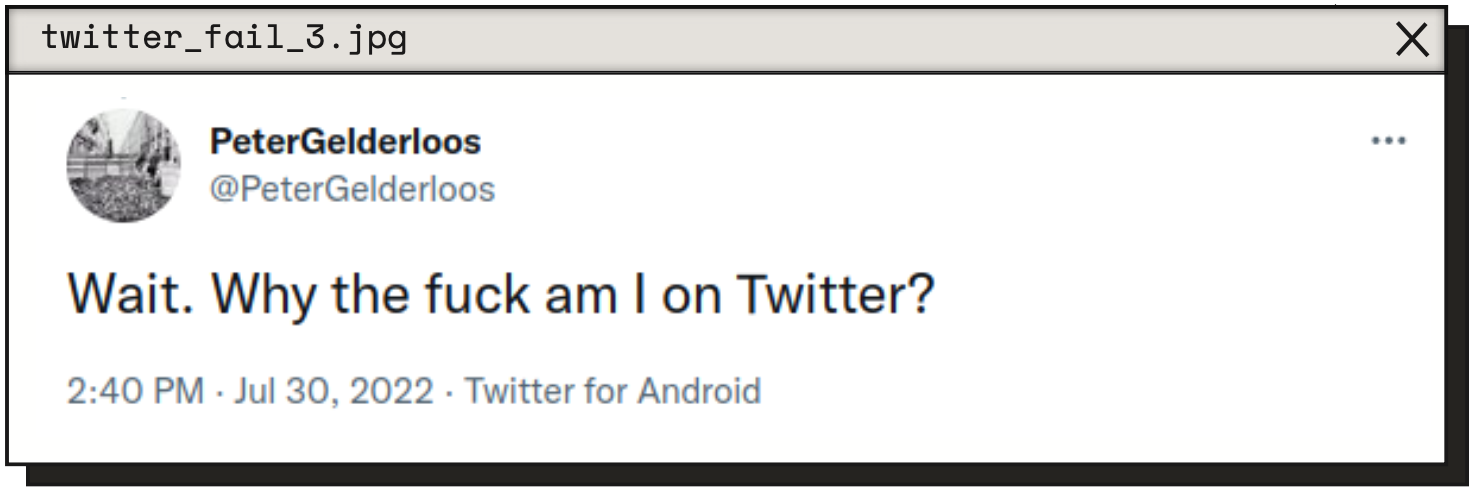
from F-91W Distro
Download fedizine for print or reading, or read the full zine online below.
PDF for printing – black and white
PDF for printing – colour cover
TLDR
For better or worse, anarchists are using social media like Twitter, Instagram, and Facebook. This sucks. Enter the Fediverse, an alternative, open-source social media network that aligns with anarchist values. Rather than being a thinly-veiled attention and data gathering capitalist vortex, the Fediverse is an actual social network, built out of a multitude of federated, autonomous, and decentralized instances. On the Fediverse, we control the infrastructure, we moderate ourselves, and we can gather and share based on our affinities and desires rather than being guided by addictive algorithms. Many anarchists who have dodged the traps of corporate social media are already here, sharing their projects, art, and ideas. Join us!
Intro

Social media and the internet are pervasive and influential. Whether or not “technology” is redeemable – even as imagined outside our present capitalist context – is an ongoing debate in anarchist circles. Maybe you believe that social media (even the anarchistic alternatives discussed here) and all its underlying infrastructure should be scrapped, buried and forgotten. Maybe you can imagine worlds where computers, servers and networks are distinct from capitalism and thus expand possibilities for freedom rather than oppress them. This is a debate for a different zine.
Wherever you stand on “technology,” you have to accept that most people in the world today are using social media to some extent, and this includes most anarchists. Even if you are not ‘on’ social media, you inevitably engage with it. Anarchist opinion pieces and news articles contain embedded tweets, and the primary source for info for any public event is a Facebook event page. Unfortunately, when people say “the discourse” they usually mean “Twitter.”
Ostensibly, many anarchists are on social media to spread anarchist ideas and news to a large audience. But it’s also very commonplace for anarchists to use social media for the more “social” reasons. To keep in touch with far-away friends (especially during the pandemic). To share art. To get inspiration. To look at memes.
Maybe anarchists should enthusiastically push against all internet-mediated relationships. Maybe. But for the sake of argument, let’s accept how dominant social media currently is, be critical of how anarchists currently use social media, and imagine or explore alternatives that are more in line with anarchist ideals. We are using the internet, and we should be trying to use infrastructure and tools that are actually empowering and in line with our values instead of selling out to ones that are actively hostile.
At the end of the day, you can still delete all your accounts and sabotage some fibre optic cables.
Twitter is shit.
Do we really need to explain why corporate social media platforms are fucking awful? Here’s a quick list:
- They are free to use because you are the product. Your data and your attention are sold to advertisers, and increasingly to other data brokers.
- To maximize profit, they are engineered to maximize the data and attention they can extract from you. They are highly addictive, feeding you constantly via algorithms and encouraging toxic social behaviour.
- They invasively spy on you (and are constantly caught spying in ways they promised they wouldn’t).
- Neither you, nor your friends have any control over these platforms, how they are moderated or what they do with your data.
- They will censor or shut down accounts without warning and without recourse.
- They cooperate willingly with our adversaries.
There are valid reasons that anarchists intentionally engage with corporate social media. Some argue it is important for anarchists to have a presence there: to reach people outside our “bubble,” to spread ideas and discourse to the broadest group of people across geographic, racial and class lines. Lots of people also use corporate social media because it’s the only way they have to stay connected to a certain group, like family or old friends. Both are valid reasons to engage with corporate social media, and we want to acknowledge them.
But just like it’s fair to say that 50% of all accounts on Twitter are bots, 90% of posts anarchists make on Twitter are no different than everyone else’s toxic shitposting. So many anarchists are totally Twitter-brained or Instagram-addicted, giving these platforms all the data and attention they want, while also becoming blind to the world, problems, people and discourse that exists outside of these curated timelines.
Gated communities
So, “maintaining a presence” aside, anarchists who use corporate social media often slip into the same toxic social dynamics, addictive usage patterns, and siloed thinking that these platforms encourage by design. But there’s another issue: corporate social media platforms are hostile gated communities. It can be difficult or impossible to view content on them without creating an account and becoming a user. Even someone visiting these platforms without an account is treated as another product, and will be invasively tracked and spied upon to the greatest extent possible. This is even true when sites like It’s Going Down embed tweets in their articles, allowing Twitter to track readers across the internet – c’mon.
There are workarounds, hacks, and safety measures you can take. But at the end of the day these platforms do not want you to view their content without getting what they want in return – they force you through hoops, and at best as an outsider you can only observe and not participate.
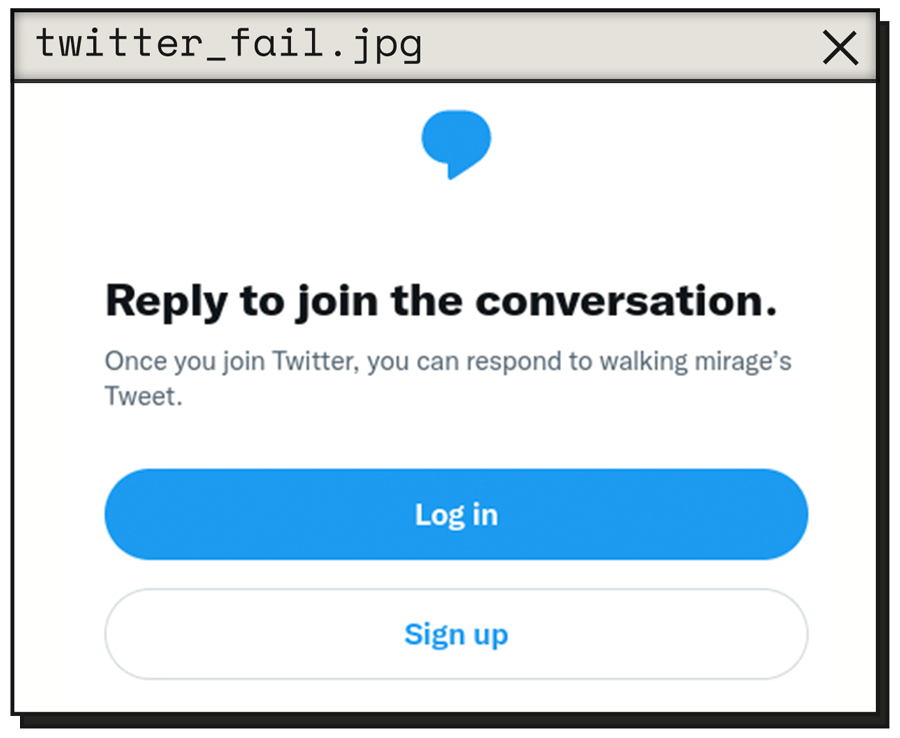
Anarchists can maintain a presence in these gated communities, for the various goals stated earlier. But it should not be our primary presence online. It shouldn’t be where we go first to share news, events, projects, insights, art, and bookfair workshop schedules. It is bullshit that so many of us willingly put our best creative and analytical work into gated platforms that then extract profit from it, forcing our friends, comrades and the anarcho-curious to sign up and sell out in order to view and engage with it.
A better timeline is possible…
Our plea is specifically for anarchists to consider that, to the extent that we are using social media (whether to stay connected, spread our ideas, or share memes), we should be far more critical of how we end up ensnared in the traps of corporate social media. We should be more enthusiastic about engaging with alternative online structures that are actually in line with our values and goals.

Federated Social Media
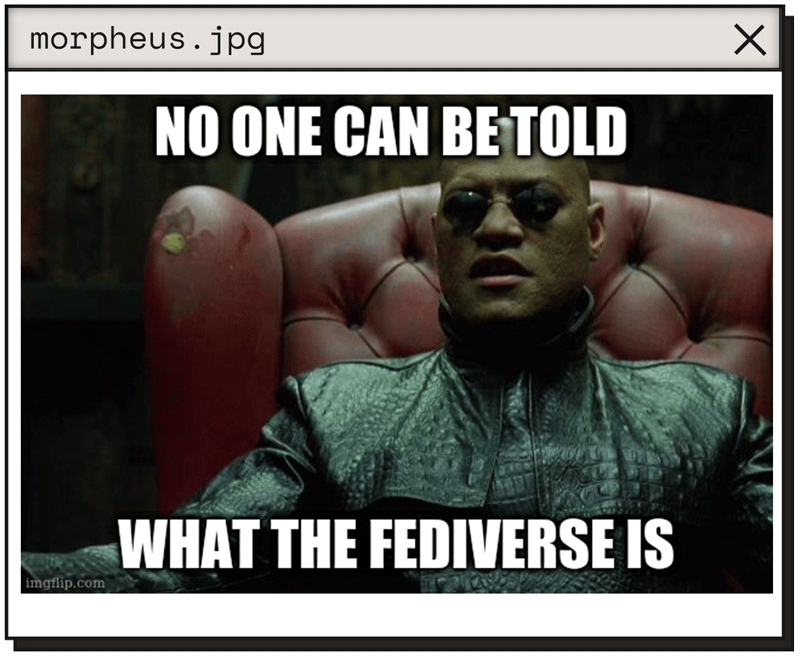
The Fediverse is a network of alternative social media that is fundamentally different from corporate social media. The Fediverse is structurally organized on a few very anarchistic principles: decentralization, autonomy, federation, openness and free association. Because it is its structural differences that make the Fediverse so compatible with anarchism, it is important to have a quick technical explanation of those structural differences. Sorry. We’ll try to keep it short, and there are pictures.
There are three main concepts to understand: interoperability, decentralization and federation.
Interoperability
A crucial concept to understand the Fediverse is interoperability. Email is interoperable. You can email someone who uses Gmail even though you use riseup.net (good for you btw!). Old SMS messages (like before iMessage) are interoperable too: you can send a text to anyone regardless of which cell phone provider they use.
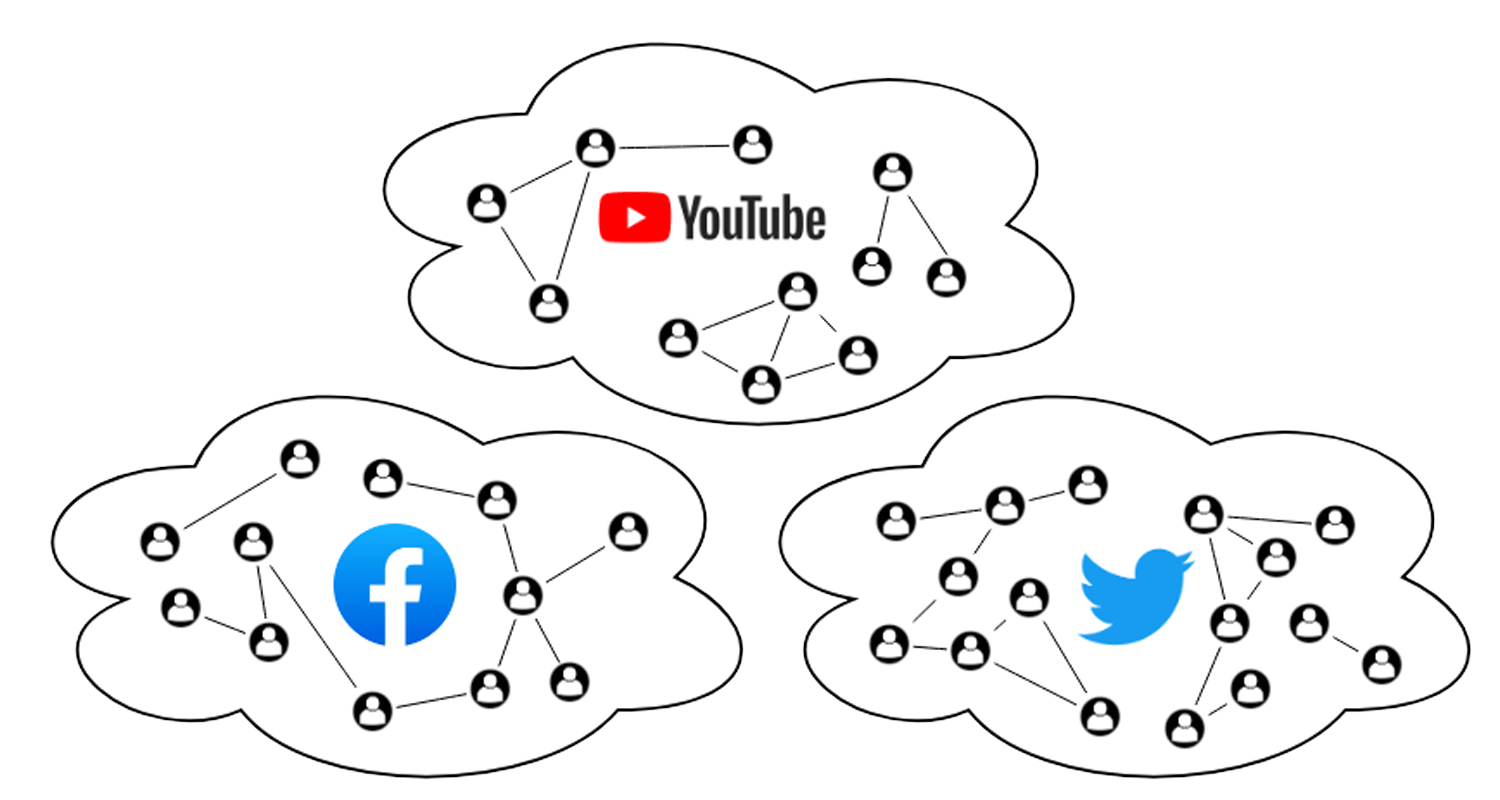
In general, different corporate social media networks are not interoperable. Instagram, Facebook, Twitter, TikTok, etc all exist in isolation from each other. You can’t post on Twitter from your Instagram account. You can’t follow or message someone on TikTok from your Facebook account (Facebook and Instagram actually do have the ability to connect somewhat, because they are both owned by Meta – this is a very small taste of interoperability!).
In contrast, the Fediverse is a network of many different social network applications that are all interoperable with each other. Each of these applications are different pieces of open-source software, presenting social media in a different way (geared more towards text, or images, or video). Some common ones are:

… and there are dozens of others. From a single user account, you can follow SubMedia’s PeerTube account for the newest System Fail episode, It’s Going Down’s Mastodon account for the latest news, and that very ~aesthetic~ nihilist distro’s Pixelfed account to see photos of their newest beautiful books and zines. Interoperability breaks the monopoly a single piece of software has on the network. Users are free to choose whatever software they want, and are still able to follow and interact with everyone else in the Fediverse.
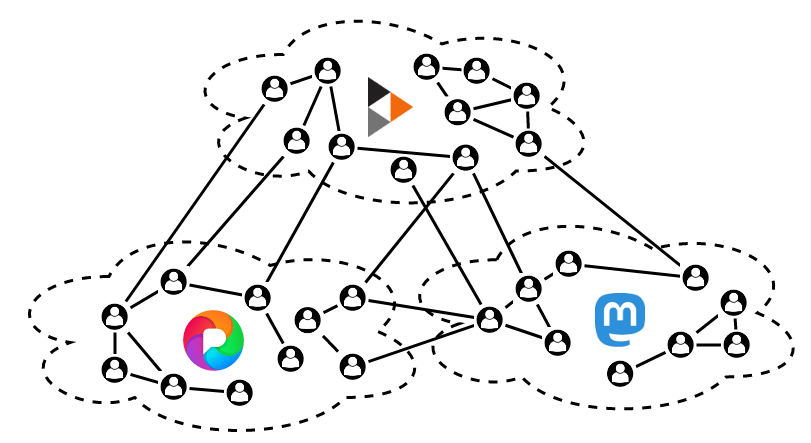
Decentralized
The Fediverse is also decentralized. Each of the corporate social media networks have one centralized server. You can only use Twitter by having an account at Twitter.com. The Fediverse is composed of thousands of different servers, each called an instance. Thanks to interoperability, all these servers can even be running different server software and still communicate with each other.
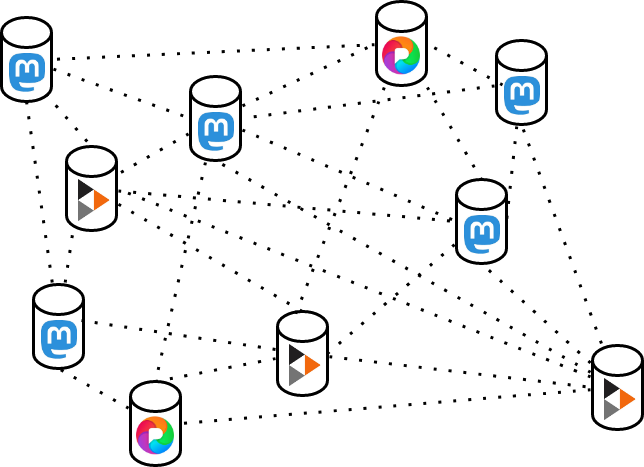
Bringing it all together… federation!
Anyone can add their own instance to the Fediverse. They can choose the server software that best suits their needs (Mastodon for microblogging, PeerTube for video – or they can even write their own server software if they want something different!).
Rather than one central Mastodon server and one central PixelFed server, there are thousands of decentralized instances. An instance can be small, hosting just one user, or can host a group of friends, or a huge, distributed online community. As a user, you have an account on one instance, your home instance. This is where you log in, check your feed, and compose new posts. But all these different instances can federate with one another, regardless of which server software they are based on, using an open protocol called ActivityPub.
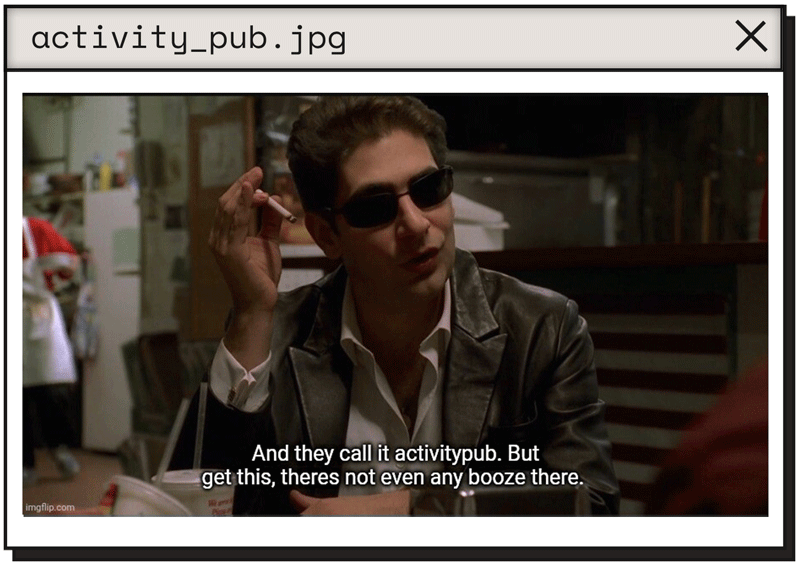
Federation allows users on any one instance to follow, connect, and interact with users on other instances. This whole network, of users hosted on different instances running different server software, is the Fediverse! 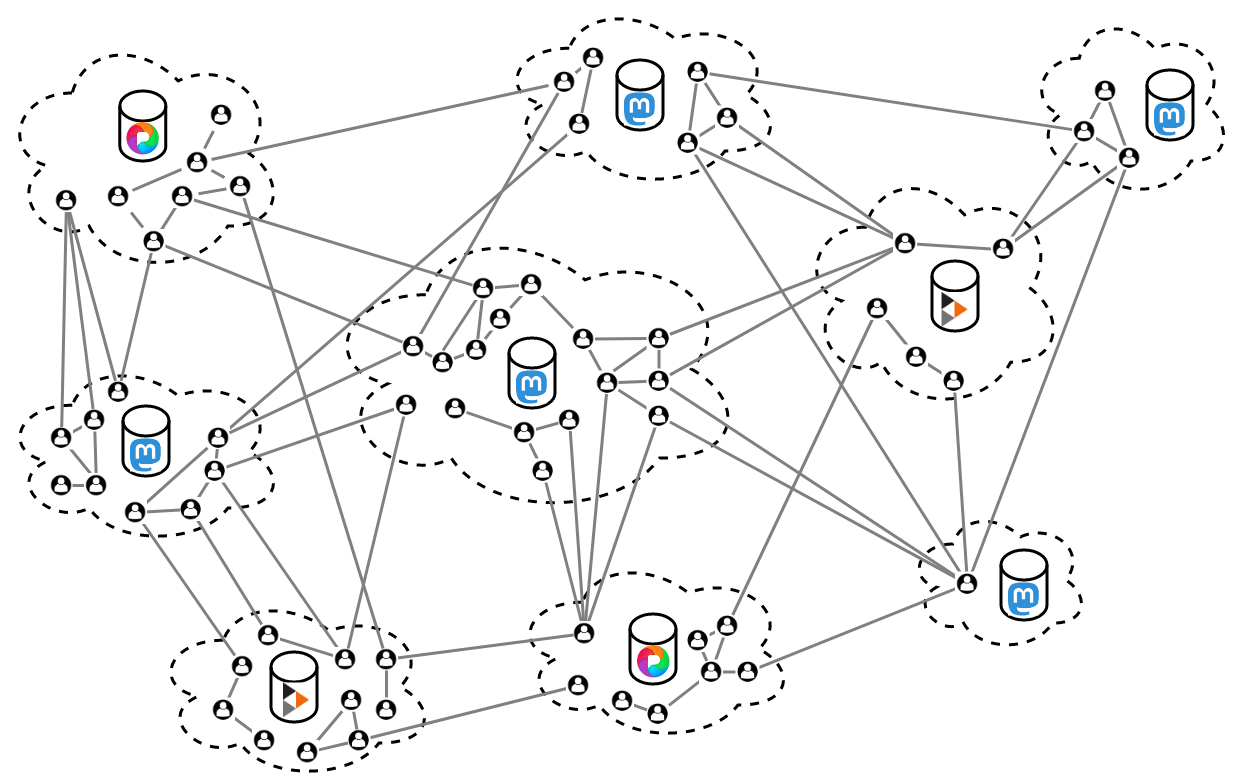
Fedi thoughts
So why does this matter to anarchists? If we are looking for ways to communicate, network, publish and share information online we should use tools that are actually designed with those goals. Corporate social media is built to generate user data and attention – it only provides a shiny, addictitve social network or publishing platform to lure us in so we will generate that data.
The Fediverse, on the other hand, exists to provide an actual social network – a place to network and share information with our existing social connections, or to make new ones. The Fediverse is structurally based on anarchistic principles like free association/affinity, autonomy and… federation. No single entity controls all the software that is compatible with the Fediverse, nor all the discrete instances that make up the Fediverse. Instances can be run by individuals or collectives and be based around whatever goals and guidelines they desire. Each instance on the Fediverse is totally autonomous in terms of what server software it uses, whose accounts are hosted there, what the local moderation policies are, how the physical servers are maintained, etc. We can even create our own software to run Fediverse instances if nothing suits our current needs (there is already a high representation of anti-fascist, queer and trans developers contributing to or starting new Fediverse softwares with the features they want to see).
On the Fediverse you can choose an instance (or establish your own) with internal and external moderation policies you vibe with. Instances decide on their own guidelines and policies for moderating user behaviour and content, and this includes how to deal with other instances that may host abusive or hostile users. Instances can choose to defederate completely from ‘badly behaved’ instances if deemed necessary.
Anyone is free to migrate to another instance or start their own instance and still be part of the same Fediverse without being barred by the structural elements of isolation and monopoly that make up corporate social media. Users have much more control over their own experience, and the only limits are autonomously decided policies for each instance!
The Fediverse is also, by default, not a gated community. Users have access to many excellent, fine-grained privacy controls, but for public posts and profiles that are intended to be widely available? Anyone with a simple web browser can view them. It is a much more accessible publishing platform compared to corporate social media (and easier than setting up a blog). The hardware requirements for viewing content on the Fediverse are very low, which allows greater accessibility to people with older phones and computers or slower internet connections. Readers won’t be prompted to “Sign Up” or be tracked just for trying to view a public post. And if someone does want to “Sign Up” to connect with you, they are not restricted to using the same software and instance you have chosen – they are free to choose based on their own needs and affinities.
Using it
Understanding the Fediverse can be complicated at first. What’s my home instance? You mean that user is on a different server? What’s the difference between the Mastodon, Pleroma, and PixelFed software and how do I choose? It’s true, it can be daunting. But we don’t think this is necessarily a bad thing. Engaging with something as potentially fraught as social media and the internet should involve users being empowered by an understanding of how it all works. To us, this seems like a better anarchist practice than simply accepting corporate products which are slick and addictive, which abstract away all the technological underpinnings and their consequences.
So that being said, while we can’t explain everything there is to know about using the Fediverse here, we’ll try to give a short overview of what using the Fediverse is like in an effort to encourage you to give it an honest try!
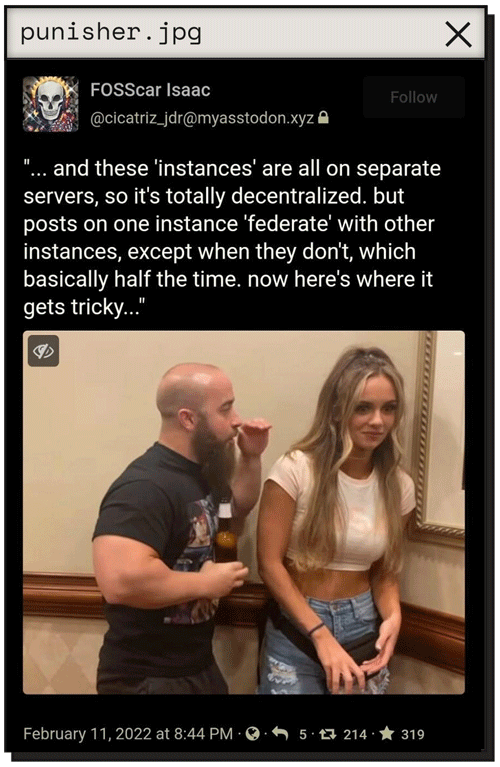
Using Mastodon
From this point on, we will mostly focus on Mastodon, which is just one part of the Fediverse. It is the most popular software, the most frictionless for new users, and the one we are most familiar with. There are millions of people using Mastodon and thousands of large and small instances. The Mastodon interface is user-friendly and there are numerous well-developed mobile apps to choose from. This experience will be similar, but different, with other Fediverse software!
Mastodon is geared towards ‘microblogging’. So it looks a lot like Twitter and Tumblr had a baby. You can reply to, like, or repost (boost) individual posts. The most immediately obvious difference to a new user is the lack of addictive algorithm feeding you sweet, sweet content. When you first join an instance, Mastodon might show you a few accounts to follow, but beyond that, your home timeline will be totally empty. Mastodon will not really suggest posts to you. It won’t recommend “People You May Know” (because it isn’t creepily spying on who else uses Mastodon from the same locations as you).
A lot of us are really used to using social media as passive consumers. The algorithm feeds you funny memes, cute animals, hot takes and bad takes to get you riled up. It can be a bit of a culture shock to start using something like Mastodon. Suddenly I have to actually choose what I see?? You aren’t going to get the deluge of content you find on an “Explore” or “For you” page. This might seem weird, but we’d argue it’s a good thing. The downsides of “the algorithm” are well known at this point. The Fediverse gives you back your control and autonomy. You get to be intentional about what’s in your feed, use it actively to, you know, be social (in whatever way works for you) without being encouraged to passively consume content.
Other users on your home instance will be most visible to you – there’s a “Local Timeline” that just shows public posts from other users on your instance, which can be a good place to start. This is a great feature for instances built around a pre-existing community or shared interests. There is also a “Global Timeline” that shows you public posts from users all over the Fediverse. These timelines are not algorithmically generated but are based on your local fediverse ‘geography’ – the other users on your home instance, and users on other instances that your instance interacts with frequently through federation.
If you want anything in your Home Timeline, you will have to follow some other accounts – maybe you can find your friends, or maybe you just go out exploring a bit and look for accounts for cool projects or with whom you have shared interests. What you get out of it is definitely proportional to what you put in. Remember that the point here is to not be sucked into an addictive doomscroll. Without an algorithm, with a quieter timeline, it’s a lot easier to pop in, see what you actually want to see and care about, and then log off.
Mastodon has some novel features that are worth highlighting from a user-experience perspective. You can easily add content warnings and image/media descriptions. There are multiple levels of privacy for each individual post (direct message, follower only, unlisted, public, and sometimes home-instance only), and way more safety and filtering controls for users – too many to describe here. The amount of control you have as a user can be a bit daunting at first, but it ultimately results in a more intentional interaction with one’s safety online than is possible with corporate social media.
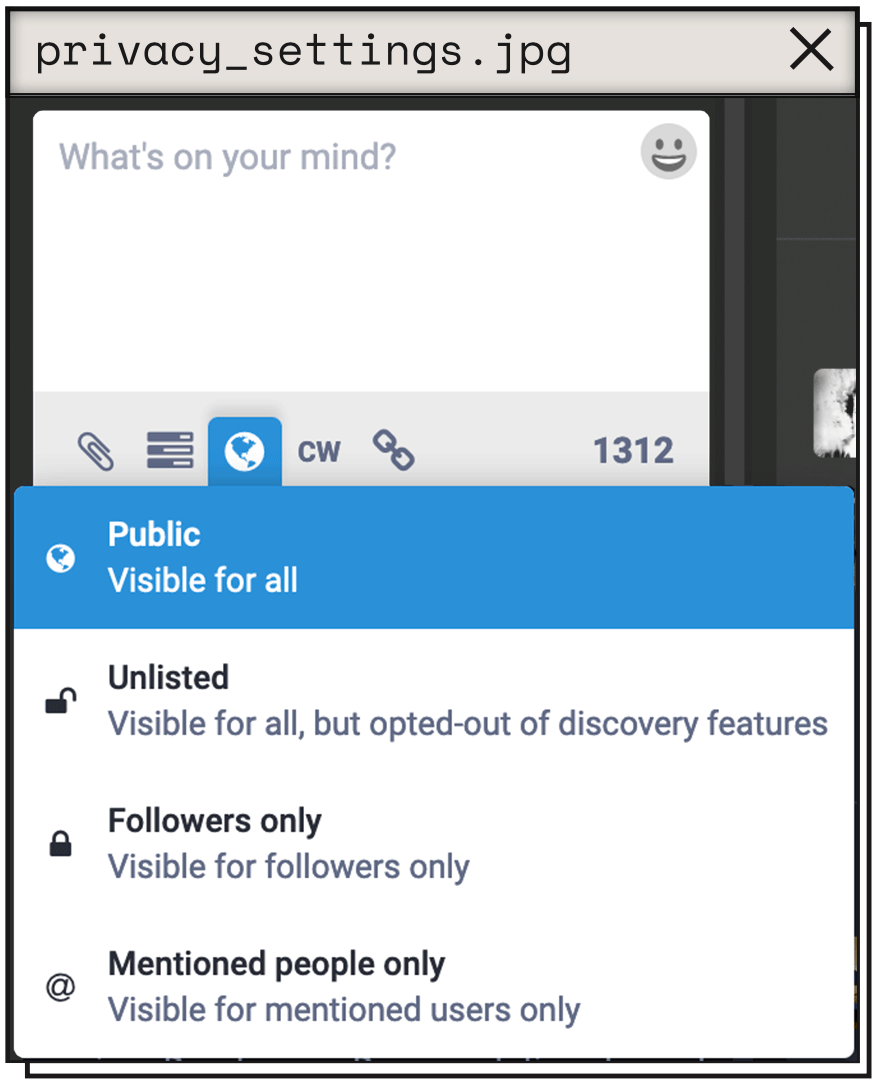
Where do I sign up? But like, actually, where do I sign up!?
At this point, if you are convinced, you may be searching in your phone’s app store for “Mastodon” or “Fediverse” or going to mastodon.com (which is oddly not for the metal band or the Fediverse app!). Stop! That’s not how to sign up for an account on the Fediverse! Remember all that talk about instances, decentralization, etc, etc, that you probably skimmed over? You need to find an instance to host your account (if you are not able to start a new instance yourself – more on that later!). There are many smaller instances which may be invite-only or based on particular interests or values, but the best way to get started is to join a large instance with open registration that is welcoming to new users. Once you get your bearings, you may notice that some of your friends or people you have affinity with are on smaller instances. Migrating your account to a new instance is easy to do, and many people will hop around a few times until they find a place they fit in!
At the time we are writing this, kolektiva.social is an anarchist Mastodon instance that seeks to be a good landing point for new anarchist Fediverse users. So that’s a great place to go and sign up. To register for an account on the Fediverse, you need to go to the instance’s website in your browser kolektiva.social and sign up for an account.
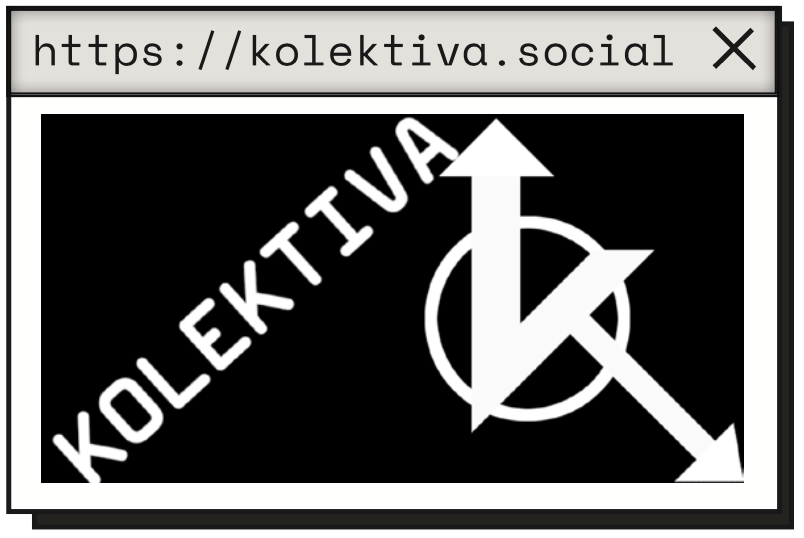
If using a mobile app on your phone is more your style, there are many apps to choose from (we recommend Toot! or metatext for iOS and Tusky or Fedilab for Android) but you need to register an account with an instance before you can use an app. Remember that on the Fediverse, your username has two parts, your username and your instance (@fedizine@kolektiva.social) – you need to enter both things in a mobile app in order to access your account. If you don’t provide your instance, your app won’t know where your account lives!
What the Fediverse isn’t
It’s important to address some common misconceptions and caveats about the Fediverse.
“But I heard Mastodon admins can read your DMs…”
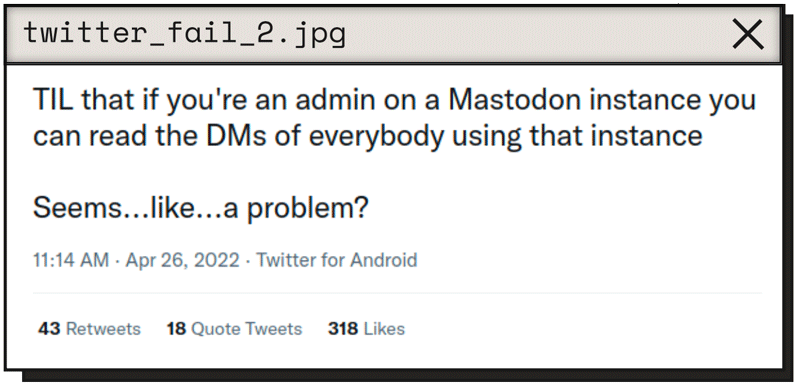
The Fediverse is not a secure encrypted chat tool. Just because we are saying it’s great for anarchists does not mean it’s a secure organizing tool or for planning sketchy stuff. It’s still social media and you should treat it as such. Whatever you post publicly is just that: public. Yes, DMs are not presently encrypted because this is logistically difficult to implement with federation. This is basically true for all corporate social media, which you also shouldn’t be using for anything where you need that level privacy or security (you think Twitter isn’t reading your DMs?). If you need secure communication, the Fediverse isn’t the place for it and there’s probably a different zine you can read.
We should mention that it is easier to browse or post to the Fediverse anonymously using tools like Tor. Running a Twitter or Instagram account anonymously for a sketchy counter-info page can be difficult or impossible, but on Mastodon it is easy.
The nazi problem
Did we say the Fediverse is resilient to censorship? Yes, there are nazis and far-right free speech “activists” here. For the same reasons anarchists become interested in the Fediverse when they get kicked off Facebook, trolls and fascists have also periodically flocked to the Fediverse. But it’s less of a problem than you’d think. Mastodon has much greater blocking and filtering tools at the individual user level than corporate social media, and instances can also decide what other instances they want to federate with or defederate from. Most instances are not interested in being harassed by nazis and other such people, and simply defederate from their instances. Instance administrators with shared politics work together to alert each other to new instances spreading hate or trolling queer and trans people so that we can block or defederate from them pre-emptively if we choose to.
Unlike with corporate social media, we are not at the mercy of absent or indifferent corporate overlords to help us with moderation, nor in a situation where underpaid outsourced labourers have to sift through endless offensive content. We are in control of our own moderation and can easily defederate from entire problem instances if we choose to, or if it is necessary – each instance can decide for itself what it’s internal and external moderation policies should be and how they should be implemented.
Start your own
Joining a big, well-established instance can be a great way to get started on the Fediverse and leave corporate social media behind. But we don’t want to all end up on One Big Anarchist Instance (imagine the moderation issues!). The power of the Fediverse lies in decentralization. So it’s crucial that people are encouraged and empowered to go off and start their own instances to host themselves, their friends, and their projects. Currently starting your own instance requires a bit of technical knowledge. You need to know some networking and sysadmin basics. Probably a little bit of Linux. But it is within reach for anyone who wants to learn, and it is getting easier all the time. Gaining these capabilities is also part of building the autonomy and empowerment of our communities. If we are using social media networks to communicate, coordinate and spread our ideas, we should be controlling the infrastructure they run on!
Case Study: we started our own instance
After a few months on kolektiva.social, we started our own instance and migrated our accounts there. At first, we invited a few close friends to join us, but soon started inviting friends and acquaintances via paper flyers we handed out at local punk shows.
The instance has been up for almost a year and grown to 135 total users, all of whom are part of our IRL community. Everyone is connected by only one or two degrees, so we haven’t had internal moderation issues (also everyone is pretty cool and nice).
People share local events, news, art, music, life updates, classified-type posts, personal rants, graffiti sightings, etc! Our instance is based on our IRL community, so there is the vibe of a drama-free local message board. But we are also connected to our neighbours in the Fediverse like kolektiva.social and other anarchist instances (hi to the nihilist instance!). Some of us venture out into the Fediverse and connect with many accounts on other instances, getting anarchist news and opinions from elsewhere, or just meeting and making new friends. It’s an extremely good feeling to know that we get to decide what to do with our own instance, but are still connected to a huge Fediverse that anyone can join.
Resource and Fediverse guides
fediverse.to – a comprehensive list of Fediverse instances
An in-depth guide to using the fediverse written by a user (thanks @elillia@transmom.love)!
joinmastodon.org – Mastodon’s documentation
fediverse.party – a huge list of Fediverse software and tools
joinfediverse.wiki – community resource for the Fediverse
runyourown.social – a guide to running your own instance
Free ideas for your new instance
- Pleroma instance for anarchists who live off-grid (there’s a surprisingly large number of these people on the Fediverse already)
- instance for a local neighbourhood (instead of NextDoor or whatever it’s called)
- Mastodon instance running as an onion service for sketchy anarchist counter-info sites and media projects to publish all their communiqués and instruction guides
- Castopod instance for anarchist podcast network
- PixelFed instance for anarchist artists
- instance for your particular strain of anarchism (even the anarcho-primitivists 😉 )
- ephemeral instance for your next bookfair or gathering
- instance for herbal practitioners and autonomous healthcare collectives
- a Bookwyrm (works like Goodreads) instance for zines and radical texts
Contact the authors
On the Fediverse: @fedizine@kolektiva.social
Or by email: fedizine (a) riseup.net
Written, re-written, designed and printed on unceded Kanien’kehà:ka territory.
Released as a zine for the Montréal Anarchist Bookfair, August 2022.
